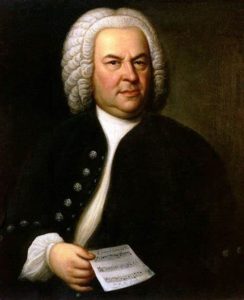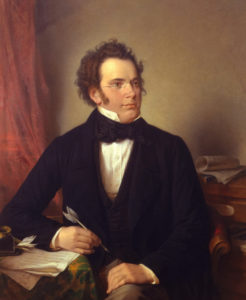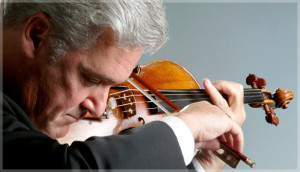SPECTACULAR CHAMBER CONCERT @ THE LEGION
The Gunn Theater in the Palace of the Legion of Honor Museum was the site for a magnificent performance, Dec. 3. 2023. Gunn Theater holds three hundred and sixteen in a jewel box setting. The San Francisco Symphony presents chamber music concerts there through the season always featuring outstanding musicians. The music selections are usually something different, something new even if, as in this program, the music is very old.
The program was all trios; two by Bach and one by Schubert. Anton Nel was the harpsichordist for the Sonata No. 3 in E major for Violin and Harpsichord, BWV 1016 and the Sonata No. 3 in G minor for Viola da Gamba and Harpsichord, BWV 1029. Alexander Barantschik, Concertmaster of the SF Symphony, was the violinist who leads the music in this Sonata. It was an audio treat to hear the harpsichord, especially as the Gunn Theater is far smaller than the Davies Hall. It awakens a different way to listen for the notes. In the Sonata No. 3 in E major the violin opens the experience with an expressive sound that seems to reach across broad vistas. It is followed by a delightful, light Allegro as though accessible to young people or even presented for the folk instead of the elite. Bach goes back to an Adagio – ma non tanto (but not too much)– which opens into keys unusual in a Bach sonata; that’s the new in the old. At the end, Bach allows the sound more energy and, as though on the brink of cliff, the music sweeps through the air on a lift off of counterpoint. Barantschik presented a marvelous touch from the elegance of the first Adagio to the delicacy of the second movement to the energy and reach of the finale.
 Johann Sebastian Bach, composer (1685-1750)
Johann Sebastian Bach, composer (1685-1750)
In the Sonata No. 3 in G minor for Viola da Gamba and Harpsichord, BWV. Peter Wyrick played the cello, and demonstrated that the Viola da Gamba has a higher pitched string than the cello so he added a string to his cello. It gave the audience the feeling that they could notice how he bowed diagonally to make the higher sound. This trio was livelier than the one in E major. The playing of the harpsichord and cello was a pleasing sound as the two sound sources found places to alternate or reach over each other’s music. The three movements ranged from Vivace to Adagio to an exciting Allegro conclusion. Did you think that Bach could not be exciting? Listen to these elegant and totally innovative pieces; you will have an exciting surprise.
The trio included Alexander Barantschik, Concertmaster of the SF Symphony, on the Naoum Blinder Chair, Violin. He has been concertmaster of the London and Bamberg Symphony Orchestras, the Netherlands Radio Philharmonic. He was concertmaster for major symphonic cycles with Michael Tilson Thomas, Rostropovich, and Bernard Haitink.
Peter Wyrick, ’cellist on the Lyman & Carol Casey Second Century Chair, served as Associate Principal Cello, 2022-2023. Previously, he was principal cello of New York’s Mostly Mozart Orchestra and associate principal cello of the New York City Opera. His chamber music collaborations include Yo -Yo Ma, Joshua Bell, Yefim Bronfman, Jean-Yves Thibaudet.
Anton Nel, pianist, has an active performing life having performed with the Cleveland, Orchestra, Chicago , Dallas, and Seattle Symphonies as well as international venues such as Wigmore Hall, the Concertgebouw, Suntory Hall, and in China, Korea, and South Africa, his home. He holds the Joe R. and Teresa Lozano Long Endowed Chair at the University of Texas at Austin. In summers he is at the Aspen Festival and School and the Ravinia Festival and its Steans Institute.
 Franz Schubert, composer, 1797-1828) (posthumous painting by Rieder, 1875)
Franz Schubert, composer, 1797-1828) (posthumous painting by Rieder, 1875)
Franz Schubert’s remarkable Piano Trio No. 1 in B-flat major, D. 898 is a soaring, gorgeous forty minute long sail to happiness. I know that art connoisseurs are suspicious of happiness and beauty, but this is art of a different species. Schubert’s genius is above it all. When he wrote this music, he was thirty years old. He had only one year more to live and to create music that is essential for us, two hundred and twenty-six years later.
From the opening Allegro moderato, Schubert shows his originality by playing with the sonata form. He writes in “wrong keys” several times. It is a gentle wake up call to the listeners, “do not let the beauty lull you so much that you will miss the floating sensation and the changing scenery of sound. The composer, Robert Schumann, was especially taken by the first movement as “graceful and virginal.” The second movement, Andante, is slower, and this writer must use the term that pops up in others’ descriptions; it is dreamlike. And yet, this dream is not one for sleep or inactivity. It carries us along on a breath as though riding on a kite through a forest. The Scherzo offers surprise musical changes keeping the listeners just enough off balance to laugh at ourselves. Schubert closes with a Rondo: Allegro vivace. It leads our imaginations and memories to cherish the moment, so lovely but never lasting. Schubert was aware that he was terribly ill. He still shared joy.
This threesome will perform again at the Gunn on Jan. 28. That concert is sold out, but it is worth it to see if someone seeking snow goes to Tahoe. There is another concert on June 2 with the same noble artists, music by Mozart, R. Strauss, and Smetana. It is too good to miss.

 The headline tells it all; the writer will elaborate briefly for readers who have not heard Pinchas Zukerman play or who wonder about Beethoven and the violin. However, the available superlatives all fall away in remembering this musical experience. On January 26, 2014, Pinchas Zukerman was both the conductor and the solo violinist for London’s Royal Philharmonic performing three works by Beethoven: Overture to The Creatures of Prometheus; Violin Concerto in D maj; Symphony No. 5. One could say it was a celestial experience if it were not that Beethoven insists upon being an earthling. The music rips right into whatever it means to be human, the myriad things it means to be human, and celebrates life here on earth. The people wanting to build that foul pipeline of tar sands oil across American lands could never have heard Beethoven. Oddly enough, Beethoven’s music somehow encompasses even them. Mr. Zukerman’s low key approach to conducting is deceptive. Those who have witnessed famous adults and highly skilled ten year olds dramatically waving their violin bows in order to tell their audience when they are playing something important and when they are ready for an ovation might find the absence of dramatics disappointing, but his style allows the music to be the only focal point. Mr. Zukerman’s playing is masterful, a joy. In the lengthy concerto it ranged from exquisite simplicity to complex, virtuosic performance that left one breathless. The concerto’s last movement is a delightful dance. The theme sounds like fun, but it is able to be playful because it dances on top of such musical complexity and Beethovenian energy. One moment in Mr. Zukerman’s performance particularly revealed how thoroughly he lives in the music. His back to the audience, he conducted with spare movements and played. He then turned toward the audience, lifted violin to chin, bow to violin, and began to play his solo part. The time between is what fascinated me. He knew physically exactly how long he had to make that 180 turn and begin to play. No rush. Mr. Zukerman would be great at the most challenging jump rope routines. Everyone has heard the 5th Symphony or at least knows how it begins. It was the theme for the Huntley/Brinkley news decades ago. It was the Victory symphony in World War II. The problem with something that we all think we know is that we often forget to listen to it. The Royal Philharmonic and Pinchas Zukerman’s performance of Beethoven’s 5th Symphony transmitted the greatness of Beethoven’s sense of life. It is possible to hear it telling the tale of human being, alone and together. The music stretches the reach of what we want to think of as Western Civilization, of Culture with the largest Capital C, of human potential good and bad. At the end, when the clowns, chimpanzees, whales, toddlers, miners, mothers, trees, lilies, and weeds, are all in the music, exuberant with life moving in every cell, the listener is elevated to thrill in being. This listener levitated above the crowded staircase out the symphony through the traffic to find her car had been smashed and robbed. This listener, reminding herself that even that was included in the 5th Symphony, even those who want to build the pipeline, was thankful to have heard it.
The headline tells it all; the writer will elaborate briefly for readers who have not heard Pinchas Zukerman play or who wonder about Beethoven and the violin. However, the available superlatives all fall away in remembering this musical experience. On January 26, 2014, Pinchas Zukerman was both the conductor and the solo violinist for London’s Royal Philharmonic performing three works by Beethoven: Overture to The Creatures of Prometheus; Violin Concerto in D maj; Symphony No. 5. One could say it was a celestial experience if it were not that Beethoven insists upon being an earthling. The music rips right into whatever it means to be human, the myriad things it means to be human, and celebrates life here on earth. The people wanting to build that foul pipeline of tar sands oil across American lands could never have heard Beethoven. Oddly enough, Beethoven’s music somehow encompasses even them. Mr. Zukerman’s low key approach to conducting is deceptive. Those who have witnessed famous adults and highly skilled ten year olds dramatically waving their violin bows in order to tell their audience when they are playing something important and when they are ready for an ovation might find the absence of dramatics disappointing, but his style allows the music to be the only focal point. Mr. Zukerman’s playing is masterful, a joy. In the lengthy concerto it ranged from exquisite simplicity to complex, virtuosic performance that left one breathless. The concerto’s last movement is a delightful dance. The theme sounds like fun, but it is able to be playful because it dances on top of such musical complexity and Beethovenian energy. One moment in Mr. Zukerman’s performance particularly revealed how thoroughly he lives in the music. His back to the audience, he conducted with spare movements and played. He then turned toward the audience, lifted violin to chin, bow to violin, and began to play his solo part. The time between is what fascinated me. He knew physically exactly how long he had to make that 180 turn and begin to play. No rush. Mr. Zukerman would be great at the most challenging jump rope routines. Everyone has heard the 5th Symphony or at least knows how it begins. It was the theme for the Huntley/Brinkley news decades ago. It was the Victory symphony in World War II. The problem with something that we all think we know is that we often forget to listen to it. The Royal Philharmonic and Pinchas Zukerman’s performance of Beethoven’s 5th Symphony transmitted the greatness of Beethoven’s sense of life. It is possible to hear it telling the tale of human being, alone and together. The music stretches the reach of what we want to think of as Western Civilization, of Culture with the largest Capital C, of human potential good and bad. At the end, when the clowns, chimpanzees, whales, toddlers, miners, mothers, trees, lilies, and weeds, are all in the music, exuberant with life moving in every cell, the listener is elevated to thrill in being. This listener levitated above the crowded staircase out the symphony through the traffic to find her car had been smashed and robbed. This listener, reminding herself that even that was included in the 5th Symphony, even those who want to build the pipeline, was thankful to have heard it.